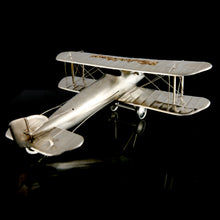Whitehead Comet - A First World War Lady Haig Presentation Model Biplane, 1917
- Regular price
- £4,800
- Sale price
- £4,800
- Regular price
-
- Unit price
- /per
Adding product to your cart
Wingspan: 15.5cm (6in)
Silver. Model of a prototype single-seat biplane, the upper wing applied with manufacturer’s name in gold flowing script ‘Whitehead Aircraft’. The fuselage inscribed 'To Lady Haig by the Employees of the Whitehead Aircraft as a token of their appreciation.14th Sept 1918’. Retailer’s name of ‘R.H Halford & Sons / Pall Mall SW’ under the starboard lower wing. Maker’s mark of James Samuel Bell. Hallmarked London, 1917.
Read more
The present model takes the form of a prototype fighter produced by John Alexander (Jack) Whitehead (1875-1949), a flamboyant self-publicist of uncertain fortune, whose meteoric career in aviation pancaked with the end of the First World War. Known to its manufacturer as the Comet, the aircraft was also known within the Whitehead works as the Boyle Scout after its principal designer, Edwin Boyle. No details of its planned armament are known, but it is reported to have flown.
The model was presented to the wife of the Commander-in-Chief of the British Expeditionary Force fighting on the Western Front, as a token of appreciation for presenting the prizes at the Whitehead Aircraft Company’s annual sports day held at Feltham House in September 1918. The event which was carefully choreographed by Whitehead (in naval uniform, according to press reports) with his characteristic showmanship and ambition that was soon to be dashed with the sudden collapse in demand for military aircraft at the Armistice. Subsequent business ventures included an after hours drinking and gambling den called the Monte Carlo Club.
Born in London’s East End, JA Whitehead emigrated to the United States in the 1890s and returned to England in 1914 as a cabinetmaker, an American citizen, and the divorced father of three children. On the 29th of August 1914 he enlisted in the Royal Naval Air Service as a Petty Officer Mechanic, only to be discharged on a month later. During his short service he went to Dunkirk, where No. 3 RNAS Squadron was based. After his discharge he worked as a carpenter at the Grahame-White Airplane Company factory in Hendon. Despite having neither a company nor any evident experience of running a factory, in 1915 Whitehead managed to win a contract from the Ministry of Munitions to build six BE2b biplanes.

On the strength of this Whitehead went into business with a small time car manufacturer called Heaps and the Whitehead Aircraft Company was born in May 1915. Having secured a new factory at Hanworth Park, Heaps was ousted, and the Whitehead Aircraft Company was awarded a further contract, this time to build Maurice Farman S11 Shorthorn planes, the first of which was completed in August 1916. Whitehead became something of a public figure and successfully mounted a campaign to have a day set aside to honour the mothers of those serving – or killed – at the front. The first such ‘Mothers’ Day’ was celebrated on 8 August 1916, Whitehead’s forty-first birthday.
At the end of 1916, the Whitehead Aircraft Company completed the Comet, its small single-seat fighting scout at its works in Richmond, Surrey. Not unlike the Sopwith Camel in general appearance - and perhaps inspired by the Sopwith type, for the production of which Whitehead was a major contractor - the aircraft was described as ‘a compact single-bay biplane, with ailerons on all four wings. The fuselage was faired to a near-circular cross section and the engine was an 80hp Le Rhone nine-cylinder rotary’.











